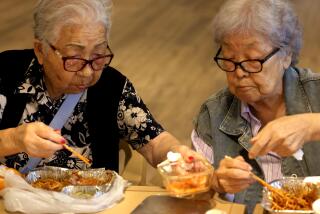A First-Class Landmark : East 1st Street in Little Tokyo Gains National Historic Status
- Share via
A stretch of 13 buildings along and near East 1st Street in Los Angeles’ Little Tokyo has been named a National Historic Landmark, overcoming earlier fears that the Northridge earthquake might have too badly harmed that cradle of Japanese American culture.
The designation makes 1st Street’s north side between San Pedro Street and Central Avenue the nation’s 2,147th formal historic landmark and boosts the properties’ eligibility for restoration grants and loans, officials in Washington said Friday.
Los Angeles County has 15 other national landmarks, such as the Los Angeles Memorial Coliseum and Watts Towers, but this is the first that entails a neighborhood.
“Especially in a place like Los Angeles, where so many historic properties are demolished, we hope this designation will get us more attention,” said Lisa Sugino of the Little Tokyo Service Center Community Development Corp. “Maybe local people will realize what a real gem we have here.”
The block anchors what once was the nation’s largest Japanese American community and “symbolizes the hardships and obstacles that this ethnic group has successfully overcome,” the federal designation proclaims.
The collection of brick low-rise buildings includes the now-empty and fenced-off Japanese Union Church, at 120 N. San Pedro St., erected in 1922 and later used as a processing center for Japanese Americans awaiting relocation to World War II detention camps; and the 1925 Hompa Hongwangi Buddhist Temple, at 119 N. Central Ave., once a focus of community life and currently the Japanese American National Museum.
The street has been on the National Registry of Historic Places for nine years in recognition of its statewide importance. Elevation to federal landmark status is rarer and requires proof of national significance. Such a move was stalled last summer when a U.S. Department of Interior review panel ordered a survey of quake damage in response to a property owner’s protest against a potential landmark designation, according to Patty Henry, a staff historian with the National Historic Landmarks Survey.
The subsequent study found that two buildings--the Japanese Union Church and the structure at 347-353 E. 1st Street that contained the Far East Cafe--were damaged enough in the January, 1994, temblor to limit entry. But both buildings are repairable and the district remains intact, the survey stated. Plans are in the works to make the church into an arts center and to restore the cafe.
In response to the survey, U.S. Interior Secretary Bruce Babbitt approved the landmark designation Monday, Henry said. While the formal paperwork is not finished, Babbitt’s office passed the word to U.S. Rep. Lucille Roybal-Allard, the Los Angeles Democrat who represents the area and worked for the landmark status.
“Preserving and restoring the rich culture of Little Tokyo ensures that future generations will gain a greater appreciation for the contributions Japanese Americans have made to American society,” Roybal-Allard said.
*
Not everyone involved was pleased.
Tony Sperl, who owns the building at 337-339 1/2 E. 1st St., originally fought the landmark designation, contending it would hinder plans to redevelop his property. On Friday, Sperl said he remained worried, but that he was also awaiting word on his application for a federal grant to restore and strengthen earthquake-damaged buildings. Built in 1882 by Sperl’s forebears as a blacksmith shop, the two-story structure that still bears the family name now needs as much as $300,000 in repairs, he said.
“If they are going to make it a historical landmark, I want to see them give me the money,” Sperl said.
*
Preservationists said landmark designation does not bring very strong protection from possible demolition. It does, however, require extra review if federal funds or permits are involved in a project that would substantially alter a landmark. Because the church and Buddhist temple are also city historic-cultural monuments, the city can delay any demolition by a year.
That part of Little Tokyo has taken some hard knocks recently, shown by the scattering of empty storefronts.
“If the landmark status brings people here, I think that’s great,” said Joanne Onaga, owner of the Little Tokyo Clayworks shop.
Starting in the 1880s, many of the early Japanese immigrants to Los Angeles were male laborers who came to work on the railroads and to live in the inexpensive hotels and boardinghouses in the 1st Street area. From those roots, a thriving Japanese American community emerged.
(BEGIN TEXT OF INFOBOX / INFOGRAPHIC)
Historic Status Part of the Little Tokyo district at 1st Street between San Pedro Street and Central Avenue has been named a National Historic Landmark.
More to Read
Sign up for Essential California
The most important California stories and recommendations in your inbox every morning.
You may occasionally receive promotional content from the Los Angeles Times.











